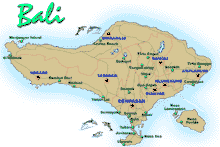|
Geographically, Bali lies between the islands of Java
and Lombok and is one of more than 17,000 islands that make up
the Indonesian Archipelago. Bali is small, stretching
approximately 140 km from east to west and 80 km from north to
south.
Running east to west and slightly off centre, are a
string of volcanic mountains, the tallest and most recently
active being Gunung Agung, which reaches 3142 m at its highest
point and last erupted in 1963.
 Lying just 8° south of the Equator, Bali boasts a tropical
climate with just two seasons a year and an average annual
temperature of around 28° C. The rich volcanic soil and
healthy monsoon season make this island extremely fertile and
a number of crops are grown here. The wide, gently sloping
southern regions play host to Bali’s famed terraced rice
paddies, among the most spectacular in the world. In the
hilly, northern coastal regions, the main produce is coffee,
copra, spices, vegetables, cattle and rice. Lying just 8° south of the Equator, Bali boasts a tropical
climate with just two seasons a year and an average annual
temperature of around 28° C. The rich volcanic soil and
healthy monsoon season make this island extremely fertile and
a number of crops are grown here. The wide, gently sloping
southern regions play host to Bali’s famed terraced rice
paddies, among the most spectacular in the world. In the
hilly, northern coastal regions, the main produce is coffee,
copra, spices, vegetables, cattle and rice.
Although there are no artifacts
or record dating back to the Stone Age, it is believed that
the first settlers in Bali migrated from Cina around 2500 BC.
By the Bronze era, around 300 BC, it is almost certain that
quite an evolved culture existed in Bali. The complex system
of irrigation and rice production still used today was
established around this time.
For
the first few centuries Anno Domini, history is vague.
Although Hindu artifacts have been found dating back to the
first century, the main religion about the time of 500 AD was
more Buddhist in influence. A Chinese scholar, Yi – Tsing, in
670 AD reported on a trip to India that he had visited a
Buddhist country called Bali.
It
wasn’t until the 11th century that Bali received the first
strong influx of Hindu and Javanese culture. With the death of
his father in around AD 1011, the Balinese Prince, Airlangga,
moved to east Java & set about uniting it under one
principality.
Having succeeded he then appointed his
brother, Anak Wungsu, as ruler of Bali. During the ensuing
period there was a reciprocation of political & artistic
ideas. The old Javanese language, Kawi, became the language
used by the aristocracy & one of the many Javanese traits
& costums adopted by the cause.
With the death of
Airlangga in the middle of the 11th century, Bali enjoyed a
period of autonomy. However, this proved to be short – lived
and in 1284 the East Javanese king, Kertanegara conquered Bali
and ruled over it from Java. In 1292 Kertanegara was murdered
& Bali took the opportunity to liberate itself once more.
However, in 1343 Bali was brought back under Javanese control
by its defeat at the hands of Gajah Mada, a general in the
last of the great Hindu – Javanese empires, the Majapahit.
With the spread of Islam through
Sumatra & Java during the 16th century, the Majapahit
empire began to collapse & a large exodus of aristocracy,
priests, artists & artisans to Bali ensued. For a time,
Bali flourished & the following centuries are considered
the Golden Age of Bali’s cultural history. The principality of
Gelgel, near Klungkung became a major centre for the Arts
& Bali became the major power in the region, taking
control of neighbouring Lombok and parts of East Java.
THE EUROPEAN INFLUENCE
Although the first Dutch
seamen set foot on Bali in 1597, it wasn’t until 1800’s that
the Dutch showed interest in colonizing the island. In 1846,
having had large areas of Indonesia under their control since
the 1700’s the Dutch government sent troops into Nothern Bali.
In 1894 Dutch forces sided with the Sasak people of Lombok in
defeating their Balinese rulers. By 1911 all the Balinese
principalities had either been defeated in battle or had
capitulated leaving the whole island under Dutch control.
After the First World War, Indonesian nationalist sentiment
was on the rise, and in 1928 Bahasa Indonesia was declared the
official national language. During World War II, the Dutch
were expelled by the Japanese, who occupied Indonesia from
1942 to 1945.
After the Japanese
defeat, the Dutch tried to regain control of their former
colonies but on the 17th August 1945 Indonesia was declared
independent by its first President, Sukarno. After four years
of fighting and strong criticism from the international
community, the Dutch government finally capitulated and in
1949 Indonesia was recognised by the world as an independent
country.
|

